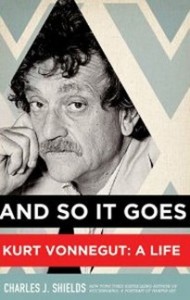And So It Goes; Kurt Vonnegut: A Life
- Share
- Tweet
- Pin
- Share

A trademark of Kurt Vonnegut’s fiction is his use of authorial intrusions, often blurring the boundaries of fiction and autobiography.
In his iconic Slaughterhouse-Five, for example, describing the toilet in the prisoner of war camp in Germany, Vonnegut writes:
“An American near Billy wailed that he had excreted everything but his brains. Moments later he said, ‘There they go, there they go.’ He meant his brains.
“That was I. That was me. That was the author of this book.”
And so it goes.
Charles Shields (who also wrote Mockingbird: A Portrait of Harper Lee) in his new biography of Kurt Vonnegut, And So It Goes; Kurt Vonnegut: A Life, offers fans of the 14 novels in the canon the opportunity to examine the relationship between the author’s life and his work. Especially interesting is the slow gestation of Slaughterhouse-Five (1969), the time that passed before the author was able to make fictional use of his horrific experience surviving the WWII firebombing of Dresden by taking ironic refuge in the basement of a slaughterhouse.
As one who first taught the novel during the early 1970s and continues to teach it from time to time up to the present, this reader especially enjoyed the portions of the biography dealing with that book, discovering the prototypes for a number of the characters.
But also fascinating was Shields’ humanization of the famous author. A major figure in American literature, Vonnegut is a complex and sometimes self-contradictory personality. In some respects he emerges as a perpetual adolescent, at once naively idealistic and selfishly inconsiderate. For example, when Vonnegut’s sister and her husband died, he and his wife immediately added nephews to their own brood, even though they were emotionally and financially challenged by the arrangement.
And then Shields tells of the author speaking during a college visit. As he explained the importance of being kind, the spiritual value of extended family and community, a young mother entered the auditorium carrying a crying child: “‘Get that damned kid out of here!’ Vonnegut barked.”
And so it goes.
Just as Billy Pilgrim travels in time in Slaughterhouse-Five revisiting scenes again and again, so does Vonnegut, both in his fiction (bringing back characters such as Kilgore Trout) and in his life (multiple romances, ended but then resumed). His literary and personal relationships often follow the same pattern, trusts violated, agreements broken.
Although Vonnegut bases Billy Pilgrim on a real-life character that he knew in the war, elements of Billy’s personality are apparent in the author: a passive-aggressive nature, a sense of loss and frustration, and a futile search for meaning in life. And while Billy can be irritating, because of his flaws, but at the same time poignantly charismatic, the same is true of Vonnegut.
Shields’ scholarship is impressive. His text is heavily footnoted and carefully documented, the work of an author who wants his biography to be definitive. At times, though, he steps into the role of psychologist with less credibility. For example, he maintains that Vonnegut’s satisfying extramarital relationship while he was teaching at the Iowa Writers’ Workshop freed his spirit, allowing him to finally write Slaughterhouse-Five.
And so it goes?
Devotees of Vonnegut’s novels will happily devour And So It Goes, and even those students required to read Slaughterhouse-Five in high school English classes may want to give it a taste. Readers will discover for themselves that Vonnegut is not only a classic author, but one who has all of those contradictory traits that make him uniquely American.

